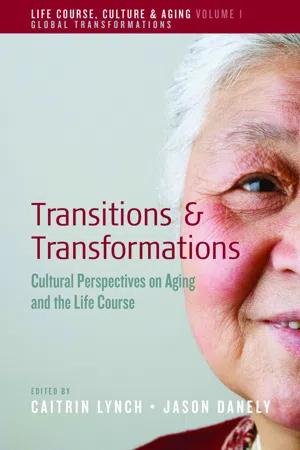
Transitions and Transformations
Cultural Perspectives on Aging and the Life Course
- 280 pages
- English
- ePUB (mobile friendly)
- Available on iOS & Android
Transitions and Transformations
Cultural Perspectives on Aging and the Life Course
About this book
Rapid population aging, once associated with only a select group of modern industrialized nations, has now become a topic of increasing global concern. This volume reframes aging on a global scale by illustrating the multiple ways it is embedded within individual, social, and cultural life courses. It presents a broad range of ethnographic work, introducing a variety of conceptual and methodological approaches to studying life-course transitions in conjunction with broader sociocultural transformations. Through detailed accounts, in such diverse settings as nursing homes in Sri Lanka, a factory in Massachusetts, cemeteries in Japan and clinics in Mexico, the authors explore not simply our understandings of growing older, but the interweaving of individual maturity and intergenerational relationships, social and economic institutions, and intimate experiences of gender, identity, and the body.
Frequently asked questions
- Essential is ideal for learners and professionals who enjoy exploring a wide range of subjects. Access the Essential Library with 800,000+ trusted titles and best-sellers across business, personal growth, and the humanities. Includes unlimited reading time and Standard Read Aloud voice.
- Complete: Perfect for advanced learners and researchers needing full, unrestricted access. Unlock 1.4M+ books across hundreds of subjects, including academic and specialized titles. The Complete Plan also includes advanced features like Premium Read Aloud and Research Assistant.
Please note we cannot support devices running on iOS 13 and Android 7 or earlier. Learn more about using the app.
Information

INDEX
Table of contents
- Cover Page
- Title Page
- Copyright Page
- Dedication
- Contents
- Illustartions
- Acknowledgments
- Section I. Frameworks
- Section II. Bodies
- Section III. Spatiality and Temporality
- Section IV. Families
- Section V. Economies
- Notes on Contributors
- Bibliography
- Index